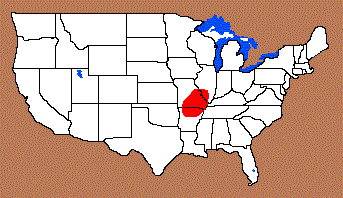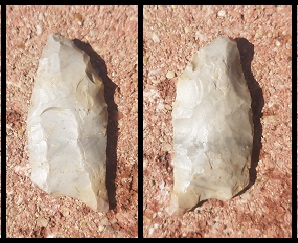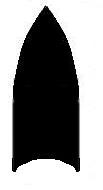Other Websites with Detailed Information:
Name Details:
Named By: J. Christopher Gillam
Named For: Multiple sites, northeastern Arkansas
Date Identified: 1996
Type Site:
Sedgwick
Cluster:
Commonly Utilized Material:
Date:
Cultural Period:
10,900 - 10,200 B.P.
(see Age Details)
Middle to Late Paleo
Late Pleistocene
Glacial Period:
Culture:
Outline is Representative of Size and Shape:
Description of Physical Characteristics and Flaking Pattern:
This is a
thin medium lanceolate point with a flattened cross section. The blade is primarily excurvate with parallel sides. The
widest part of the blade generally occurs at the top one third to one half of the blade giving the point a “stub nosed” appearance. The base concave with many examples being deeply concave with basal grinding. Some examples has the remnants of a nipple at the center of the base which is the fluting platform remnants. The faces of the blade are fluted most commonly the entire length of the blade, but may only extend to sixty percent of the face. Similar to Folsom
points, the basal edge is commonly basally bi-facially flaked after the fluted channel was made.
Distribution:
Distribution Comments:
This point is frond in the White River valley of southern Missouri and into northeastern Arkansas and into the Jack and Current river valley of southeastern Missouri and southwestern Illinois.

Similar Points:
Alder, Allen, Angostura, Arkabutla, Belen, Clovis, Coldwater, Cumberland, Golondrina, Goshen, Green
River, Folsom, Midland, Milnesand, Plainview Related / Associated Points:
Additional Comments:
This type is more commonly found in larger Mississippian sites like Cahokia in Illinois. Ray (2000 point out that these are similar to the Folsom point found in the Plain States, but tend to be slightly narrower and shorter than commonly seen in the Folsom type. Many examples have been re-sharpened
after the point was fluted which reduces the size of the flute and may place flaking scars in the fluted channel. Basal flaking after the point has been fluted may remove the the fluting platform
(nipple), but can be differentiated from other Clovis type point is that basal flaking after the point is fluted is not seen in any Clovis type point.
Cumberland points are credited from coming from the same fluting technology that was used to flute Folsom point. This type may represent a the same technology as it moved from the Plains states into the
Mississippi River valley and into the Tennessee River valley influencing points such as the Cumberland point.
Pictures:


Other points in this Cluster:
Point Validity: Valid Type
Gillam is an archaeologist for the South Carolina Institute of Archaeology and Anthropology
at the University of South Carolina. This type was named in a professional publication and has many professional references. This is considered a valid type.
.
Age Details:
Ray (2000) notes that no Sedgwick points have been found in stratified with other fluted points, not have radio-carbon dating has been associated with these points. Dates are based on
similar Folsom points which appear to share the same technological techniques as the Sedgwick point.
Pictures Provided By:
Modification of illustration by Don Dickson, 1999
Dakota Johnson
Additional information provided by:
Loyd Doty
References: (See Reference Page, Entry Number):
30
Sedgwick Projectile Point, Sedgwick Arrowhead




